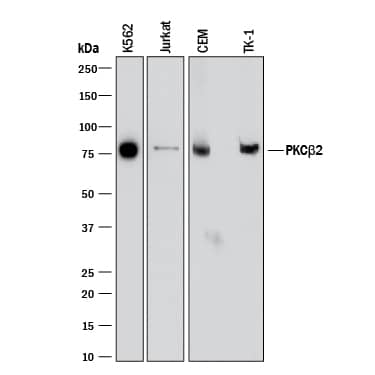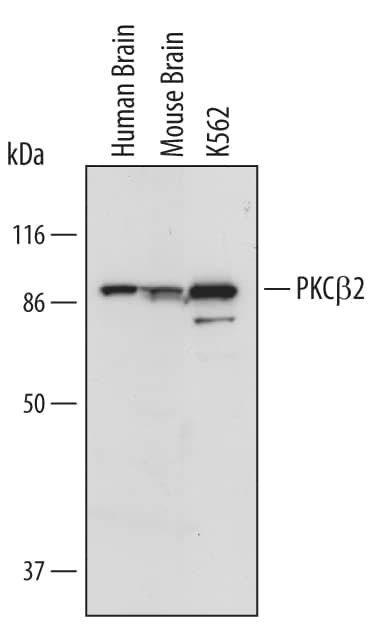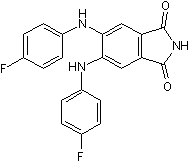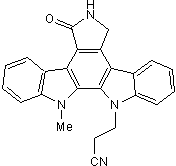PKC beta 2 Products
Members of the Protein Kinase C (PKC) family are serine/threonine protein kinases that play a key regulatory role in a number of cellular functions including cell growth and differentiation, hormone secretion, and gene expression. Multiple genes and alternative splicing result in three subfamilies, which differ in their co-factor requirements: conventional PKC isoforms (alpha, beta 1, beta 2, and gamma) which require calcium and phosphatidylserine (PS), diacylglycerol (DAG) or phorbol esters for activation; novel isoforms (delta, epsilon, eta, and theta), which are calcium-independent but are still regulated by PS, DAG, or phorbol esters; and atypical isoforms (iota/lambda and zeta), which are calcium-independent and do not require PS, DAG, or phorbol esters for activation. PKC beta 2 regulation of c-myc expression has been shown to suppress insulin gene transcription in pancreatic beta-cells implicating PKC beta 2 for some of the beta-cell glucose toxicity found in diabetes.
8 results for "PKC beta 2" in Products
8 results for "PKC beta 2" in Products
PKC beta 2 Products
Members of the Protein Kinase C (PKC) family are serine/threonine protein kinases that play a key regulatory role in a number of cellular functions including cell growth and differentiation, hormone secretion, and gene expression. Multiple genes and alternative splicing result in three subfamilies, which differ in their co-factor requirements: conventional PKC isoforms (alpha, beta 1, beta 2, and gamma) which require calcium and phosphatidylserine (PS), diacylglycerol (DAG) or phorbol esters for activation; novel isoforms (delta, epsilon, eta, and theta), which are calcium-independent but are still regulated by PS, DAG, or phorbol esters; and atypical isoforms (iota/lambda and zeta), which are calcium-independent and do not require PS, DAG, or phorbol esters for activation. PKC beta 2 regulation of c-myc expression has been shown to suppress insulin gene transcription in pancreatic beta-cells implicating PKC beta 2 for some of the beta-cell glucose toxicity found in diabetes.
| Reactivity: | Human, Mouse |
| Details: | Mouse IgG1 Monoclonal Clone #469827 |
| Applications: | WB, IHC |
Recombinant Monoclonal Antibody
| Reactivity: | Human, Mouse, Rat |
| Details: | Rabbit IgG Monoclonal Clone #N11-S |
| Applications: | WB, ELISA, ICC/IF, IP |
| Reactivity: | Human, Mouse |
| Details: | Sheep IgG Polyclonal |
| Applications: | WB |
| Reactivity: | Human, Mouse |
| Details: | Mouse IgG1 Monoclonal Clone #469832 |
| Applications: | WB |
Recombinant Monoclonal Antibody
| Reactivity: | Human, Mouse, Rat |
| Details: | Rabbit IgG Monoclonal Clone #SR2824 |
| Applications: | IHC, WB, ICC/IF, Flow, IP |
Selective inhibitor of PKCβII
| Chemical Name: | 5,6-bis[(4-Fluorophenyl)amino]-1H-isoindole-1,3(2H)-dione |
| Purity: | ≥99% (HPLC) |
Potent protein kinase C inhibitor; selective for α and β isozymes
| Chemical Name: | 5,6,7,13-Tetrahydro-13-methyl-5-oxo-12H-indolo[2,3-a]pyrrolo[3,4-c]carbazole-12-propanenitrile |
| Purity: | ≥95% (HPLC) |
Selective antagonist of Mfn1-βIIPKC association
| Purity: | ≥95% (HPLC) |



![Western Blot: PKC beta 2 Antibody (N11-S) [NBP3-08202] Western Blot: PKC beta 2 Antibody (N11-S) [NBP3-08202]](https://resources.bio-techne.com/images/products/PKC-beta-2-Antibody-N11-S-Western-Blot-NBP3-08202-img0001.jpg)


![Western Blot: PKC beta 2 Antibody (SR2824) [NBP3-27716] -](https://resources.bio-techne.com/images/products/nbp3-27716_rabbit-pkc-beta-2-mab-sr2824-75202410133413.jpg)



